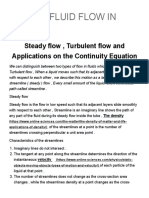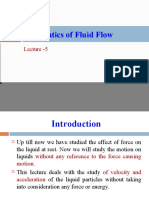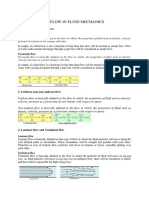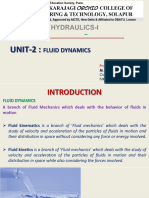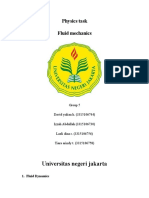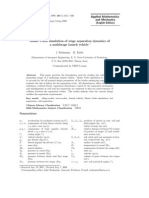Path Line
Path Line
Uploaded by
Aien Nurul AinCopyright:
Available Formats
Path Line
Path Line
Uploaded by
Aien Nurul AinOriginal Description:
Copyright
Available Formats
Share this document
Did you find this document useful?
Is this content inappropriate?
Copyright:
Available Formats
Path Line
Path Line
Uploaded by
Aien Nurul AinCopyright:
Available Formats
Many civil engineering problems in fluid mechanics are concerned with fluids in motion.
The distribution of potable water, the collection of domestic sewage and storm water, and the wave actions on offshore structures are common examples. The viscosity of water is small and therefore in most hydraulic problems associated with civil engineering it is reasonable to ignore the effect of shear forces. The most common methods to identify velocity of flow are pathlines, streaklines and streamlines. PATHLINE is the line traced by a given particle. This is generated by injecting a dye into the fluid and following its path by photography or other means. It also the trajectories that individual fluid particles follow. These can be thought of as a "recording" the path of a fluid element in the flow takes over a certain period. The direction the path takes will be determined by the streamlines of the fluid at each moment in time.
Defined by mathematical equation;
The suffix indicates that we are following the motion of a fluid particle. Note that at point the curve is parallel to the flow velocity vector , where the velocity vector is evaluated at the position of the particle at that time .
STREAMLINE
An important concept in the study of aerodynamics concerns the idea of streamlines. A streamline is a path traced out by a massless particle as it moves with the flow. It is easiest to visualize a streamline if we move along with the body (as opposed to moving with the flow). The figure above shows the computed streamlines around an airfoil and around a cylinder. In both cases, we move with the object and the flow proceeds from left to right. Since the streamline is traced out by a moving particle, at every point along the path the velocity is tangent to the path. Since there is no normal component of the velocity along the path, mass cannot cross a streamline. The mass contained between any two streamlines remains the same throughout the flowfield. We can use Bernoulli's equation to relate the pressure and velocity along the streamline. Since no mass passes through the surface of the airfoil (or cylinder), the surface of the object is a streamline. Bernoulli's equation is a direct result of the law of conservation of energy, only it is being applied to fluids. Bernoulli's equation is another equation dependent upon an ideal fluid, and states that: P + v + gy = P + v + gy Or can also be stated as: P + v + gy = constant
STREAMLINE FLOW OF FLUIDS When a fluid's particles all move along the same smooth path, the flow is said to be streamline, or laminar. In streamline flow, each path that the particles follow is called a streamline. No two streamlines can cross each other in standard flow. This effect can be seen in wind tunnels. Notice that in pictures (a) and (c), none of the streamlines cross one of the others. Another property of streamlines, is that the streamline will always be in the same direction as the velocity of the fluid. Laminar flow (or streamline flow) occurs when a fluid flows in parallel layers, with no disruption between the layers. At low velocities the fluid tends to flow without lateral mixing, and adjacent layers slide past one another like playing cards. There are no cross currents perpendicular to the direction of flow, nor eddies or swirls of fluids. In laminar flow the motion of the particles of fluid is very orderly with all particles moving in straight lines parallel to the pipe walls. In fluid dynamics, laminar flow is a flow regime characterized by high momentum diffusion and low momentum convection.
As a fluid moves through a pipe that changes in size, there is a relationship between the crosssectional area (the area that the fluid moves through) and the velocity of the fluid. The relationship between area and velocity for a fluid. This relationship is described in the equation of continuity to be: Av = Av However, when we look at it as an ideal fluid, the densities cannot change, and must remain constant. That is to say, = . Therefore the new equation is: Av = Av From this equation, we can say that as the area of the pipe increases, the velocity of the fluid will decrease, and as the area decreases, velocity increases.
STREAMTUBE In fluid flow, an imaginary tube whose wall is generated by streamlines passing through a closed curve. Imagine a set of streamlines starting at points that form a closed loop (figure 18).
Figure 18. Streamlines forming a streamtube. These streamlines form a tube that is impermeable since the walls of the tube are made up of streamlines, and there can be no flow normal to a streamline (by definition). This tube is called a streamtube. From mass conservation, we see that for a steady, one-dimensional flow, the mass-flow rate is constant along a streamtube. In a constant density flow, therefore, the cross-sectional area of the streamtube gives information on the local velocity. As an example, consider steady, constant density flow over a cylinder, where the cylinder axis is normal to the direction of the incoming flow (figure 19).
Figure 19. Flow over a cylinder. Far upstream of the cylinder, the flow is uniform in all directions (we could call this a zerodimensional flow). The flow near the cylinder varies in the streamwise and normal directions but not in the spanwise direction. So the flow near the cylinder is two-dimensional. In this region the streamlines come closer together, and the area between them decreases. Since the density is constant, the velocity must increase according to the principle of mass conservation. For constant density flow, wherever the area between streamlines decreases, the velocity increases. This is exactly similar to what happens with constant-density flow through a duct or a pipe --- if the area decreases, the velocity increases so that the volume flow rate is maintained constant (volume flow rate out must equal volume flow rate in by continuity). At a reasonable speed for a reasonably sized cylinder (more precisely, at Reynolds numbers that are not too small), the maximum flow velocity in the region where the streamtubes take their minimum area is about 1.74 times the velocity in the far-field. As the flow passes over the shoulder of the cylinder, it separates (we saw a similar separation phenomenon in the diffuser flow shown in figure 10). Large eddying motions form in the wake of the cylinder, and the wake flow is unsteady and three-dimensional. Streamlines become very difficult to visualize and interpret in this region.
You might also like
- Spreader BeamDocument7 pagesSpreader BeamAnonymous sfkedkymNo ratings yet
- Home Test 1 PDFDocument3 pagesHome Test 1 PDFGooftilaaAniJiraachuunkooYesusiin0% (1)
- Models - Plasma.drift Diffusion TutorialDocument14 pagesModels - Plasma.drift Diffusion TutorialbkmmizanNo ratings yet
- Problems 0Document15 pagesProblems 0Pasha Tan100% (1)
- Engineering Mechanics PPT 1Document48 pagesEngineering Mechanics PPT 1muralikrishna1917100% (4)
- Hydraulics IM 2023 2024final TermDocument131 pagesHydraulics IM 2023 2024final TermFranz Aliber Pineda AlipioNo ratings yet
- Hydra 325 - Im - 2024 - Ce Dept-56-177Document122 pagesHydra 325 - Im - 2024 - Ce Dept-56-177Aron GantanNo ratings yet
- Hydraulics IM 2023 2024final TermDocument122 pagesHydraulics IM 2023 2024final TermFranz Aliber Pineda AlipioNo ratings yet
- Streamline and Turbulent FlowDocument4 pagesStreamline and Turbulent FlowsureshNo ratings yet
- CE 322 - Week 7 - Lecture 1Document2 pagesCE 322 - Week 7 - Lecture 1Nickson KomsNo ratings yet
- Fluid-Flow Concepts and Basic EquationsDocument127 pagesFluid-Flow Concepts and Basic EquationsAli Alkassem100% (1)
- Stream FunctionDocument6 pagesStream FunctionMuhummad ZeeshanNo ratings yet
- Unit2Document24 pagesUnit2Manav HnNo ratings yet
- Fluid Mech Part2Document9 pagesFluid Mech Part2jimmymungai018No ratings yet
- Streamlines, Streak Lines, and Pathlines - Wikipedia, The Free EncyclopediaDocument5 pagesStreamlines, Streak Lines, and Pathlines - Wikipedia, The Free Encyclopediaanbumani_10No ratings yet
- Chapter 4 Fluid Kinematics PDFDocument11 pagesChapter 4 Fluid Kinematics PDFSoban MalikNo ratings yet
- Path Line and Stream LineDocument9 pagesPath Line and Stream LineNikin KannolliNo ratings yet
- Module 1 Fluid Flow in Pipes - Me 319-Me32s3 - Fluid MachineriesDocument6 pagesModule 1 Fluid Flow in Pipes - Me 319-Me32s3 - Fluid MachineriesOkay PrintingNo ratings yet
- FM Unit 02Document44 pagesFM Unit 02ASHOKNo ratings yet
- Momentum TransportDocument127 pagesMomentum TransportHarry100% (2)
- Momentum TransferDocument47 pagesMomentum TransferVishwath RamNo ratings yet
- Chapter 4Document12 pagesChapter 4Zebrhan GebremariamNo ratings yet
- Chapter 3 Fluid KinematicsDocument15 pagesChapter 3 Fluid Kinematicsaduyekirkosu1scribdNo ratings yet
- FM Home AssignmentDocument15 pagesFM Home AssignmentकौशलNo ratings yet
- 1PHY1501PT Unit 4Document5 pages1PHY1501PT Unit 4Anand PrajapatiNo ratings yet
- Lecture 4 - Fluid FlowDocument34 pagesLecture 4 - Fluid Flowisrael moizo dintsiNo ratings yet
- Lecture 6 - Marine Hydrodynamics I - Fluid Kinematics KineticsDocument31 pagesLecture 6 - Marine Hydrodynamics I - Fluid Kinematics KineticsMohamedElSakaNo ratings yet
- FM 1 IntroductionDocument37 pagesFM 1 IntroductionMaherNo ratings yet
- CBSE Class 11 Physics Chapter 10 Mechanical Properties of Fluids Revision NotesDocument37 pagesCBSE Class 11 Physics Chapter 10 Mechanical Properties of Fluids Revision NotesSachin BishtNo ratings yet
- Continuity EquationDocument2 pagesContinuity EquationKASHIF USMAN L1S16MSME0003No ratings yet
- Momentum TransportDocument16 pagesMomentum TransportIbrar Ul HaqNo ratings yet
- Fluid Mechanics Lecture Notes - Module3Document41 pagesFluid Mechanics Lecture Notes - Module3Azad PatelNo ratings yet
- Fluid Flow ConceptsDocument8 pagesFluid Flow Conceptskim adrian bangayanNo ratings yet
- Laminar FlowDocument4 pagesLaminar FlowPro GamerNo ratings yet
- Lecture-5-Kinematics of Fluid FlowDocument26 pagesLecture-5-Kinematics of Fluid FlowAmmarNo ratings yet
- fluid kinematics-1Document9 pagesfluid kinematics-1tjforex6No ratings yet
- Lectures 3-1 PDFDocument46 pagesLectures 3-1 PDFeko dateshidzeNo ratings yet
- Fluid Flow PDFDocument9 pagesFluid Flow PDFMêhrän AlîNo ratings yet
- Lecture-5-Kinematics of Fluid FlowDocument41 pagesLecture-5-Kinematics of Fluid Flowmj4893968No ratings yet
- 1 Pathline, Streakline, Streamlines and Velocity ProfilesDocument23 pages1 Pathline, Streakline, Streamlines and Velocity ProfilesFazelah YakubNo ratings yet
- Fluid Kinematics: GP Capt NC ChattopadhyayDocument32 pagesFluid Kinematics: GP Capt NC ChattopadhyayHammad PervezNo ratings yet
- Translation, Rotation and Deformation in FluidsDocument22 pagesTranslation, Rotation and Deformation in FluidsPlutoFXNo ratings yet
- Define Continuity EquationDocument2 pagesDefine Continuity EquationGitha GulNo ratings yet
- Types of Fluid Flow in Fluid Mechanics: 1. Steady and Unsteady FlowDocument15 pagesTypes of Fluid Flow in Fluid Mechanics: 1. Steady and Unsteady FlowRenjith RajendraprasadNo ratings yet
- Fluid FlowDocument8 pagesFluid Flowking khanNo ratings yet
- SLO 6.1.1 Define Streamline and Turbulent Flow and State The Conditions For Turbulent FlowDocument3 pagesSLO 6.1.1 Define Streamline and Turbulent Flow and State The Conditions For Turbulent Flowkashif noor azeemiNo ratings yet
- Chapter 4 - Fluid KinematicsDocument53 pagesChapter 4 - Fluid KinematicsDawit MengisteabNo ratings yet
- Viscous Flow in Pipes: Internal Flow External FlowDocument9 pagesViscous Flow in Pipes: Internal Flow External FlowShanzib Sadhukhan ShubhoNo ratings yet
- Chapter Five Fluid Dynamics: 2. Uniform Flow, Steady FlowDocument21 pagesChapter Five Fluid Dynamics: 2. Uniform Flow, Steady FlowŚæd ÖsmąņNo ratings yet
- Fluid Flow in Rocket NozzlesDocument24 pagesFluid Flow in Rocket NozzlesVenkat Akella100% (1)
- Unit-II Fluid DynamicsDocument93 pagesUnit-II Fluid DynamicsFarhan KaziNo ratings yet
- Characteristics of Turbulent FlowDocument30 pagesCharacteristics of Turbulent FlowmuthuNo ratings yet
- Hydraulics: The Science of Hydraulics. Hydraulics Is Defined As That Branch of Science Which Treats ofDocument24 pagesHydraulics: The Science of Hydraulics. Hydraulics Is Defined As That Branch of Science Which Treats ofAj SobremonteNo ratings yet
- Lecture 4Document27 pagesLecture 4Muneeb RehmanNo ratings yet
- Chapter 3 Fluid Mechanics For EngineeringDocument51 pagesChapter 3 Fluid Mechanics For EngineeringAnn RazonNo ratings yet
- Universitas Negeri Jakarta: Physics Task Fluid MechanicsDocument22 pagesUniversitas Negeri Jakarta: Physics Task Fluid Mechanicsizzah anneNo ratings yet
- Lecture-5-Kinematics of Fluid FlowDocument34 pagesLecture-5-Kinematics of Fluid FlowRIZWAN KHANNo ratings yet
- Introduction To Fluid Mechanics...Document27 pagesIntroduction To Fluid Mechanics...Dustin HendersonNo ratings yet
- Fluid Mechanics: Types of FlowDocument15 pagesFluid Mechanics: Types of FlowAL SniperNo ratings yet
- Flow1 PDFDocument9 pagesFlow1 PDFArkadu JyothiprakashNo ratings yet
- Surface TensionDocument8 pagesSurface Tensionkim jeonNo ratings yet
- Unit 3&4Document100 pagesUnit 3&4utpaltanimaNo ratings yet
- Hag enDocument7 pagesHag enAnh Viet VuNo ratings yet
- 3 - Fluid Kinematics and DynamicsDocument35 pages3 - Fluid Kinematics and DynamicsAbdullah AkishNo ratings yet
- Ctod Testing - TwiDocument8 pagesCtod Testing - TwiYASH BHAVSARNo ratings yet
- UZB 318E Finite Element Method Homework - Ii: Prof. Dr. Vedat Ziya DOĞANDocument8 pagesUZB 318E Finite Element Method Homework - Ii: Prof. Dr. Vedat Ziya DOĞANfatih reyhanNo ratings yet
- Forces of Friction ComponentsDocument13 pagesForces of Friction ComponentsImran MuhammadNo ratings yet
- Liouville's Theorem: 3N I I I I I 1Document18 pagesLiouville's Theorem: 3N I I I I I 1Sadaf KhanNo ratings yet
- Dimensional AnalysisDocument27 pagesDimensional AnalysisOwais EngrNo ratings yet
- Rust Specs BookDocument35 pagesRust Specs BookjanNo ratings yet
- Heat-2: Theory and Exercise BookletDocument53 pagesHeat-2: Theory and Exercise BookletVamsi KrishnaNo ratings yet
- The Moon Has No GravityDocument2 pagesThe Moon Has No GravityDovydas AlejūnasNo ratings yet
- Applied Mathematics and Mechanics: (English Edition)Document16 pagesApplied Mathematics and Mechanics: (English Edition)Anonymous IqCUJjOINo ratings yet
- Assignment GeoEQDocument11 pagesAssignment GeoEQKamalKishorKumarNo ratings yet
- Chapter 1 PFE 201Document41 pagesChapter 1 PFE 201Preeti BirwalNo ratings yet
- CH E 350, Process Heat Transfer Fall 2010: Course ContentDocument2 pagesCH E 350, Process Heat Transfer Fall 2010: Course Contentaly_wael71No ratings yet
- Chapter 9: RotationDocument28 pagesChapter 9: Rotationjose luisNo ratings yet
- Welded Connections in High Strength Cold-Formed Steels PDFDocument11 pagesWelded Connections in High Strength Cold-Formed Steels PDFAli KhalafNo ratings yet
- Guideline For Examining Failed Parts (1000, 7000Document102 pagesGuideline For Examining Failed Parts (1000, 7000Desalegn AbateNo ratings yet
- Magnetism Lecture NotesDocument14 pagesMagnetism Lecture NotesPrashant D BijayNo ratings yet
- Design Methods Forthe Reinforcement of Highway Slopes by Reinforced Soil and Soil Nailing TechniquesDocument108 pagesDesign Methods Forthe Reinforcement of Highway Slopes by Reinforced Soil and Soil Nailing TechniquesNita Bogdan100% (1)
- Example5 FatigueTools WS02-ENDocument19 pagesExample5 FatigueTools WS02-ENJosé Luciano Cerqueira CesarNo ratings yet
- User Guide Sika Carbodur TR55Eurocode2 EnglishDocument52 pagesUser Guide Sika Carbodur TR55Eurocode2 EnglishMihaiNo ratings yet
- SM Question BankDocument8 pagesSM Question BankANKIT SWARNKARNo ratings yet
- 11 Physics Fluids WorksheetDocument2 pages11 Physics Fluids WorksheetMINI SINGHNo ratings yet
- CMT Lesson 2Document14 pagesCMT Lesson 2April Jhen BenavidezNo ratings yet
- Modeling of Asymmetric Shear Wall-Frame Building Structures PDFDocument8 pagesModeling of Asymmetric Shear Wall-Frame Building Structures PDFmagdy bakryNo ratings yet
- SPE 157977 Casing Thermal Stress and Wellhead Growth Behavior AnalysisDocument12 pagesSPE 157977 Casing Thermal Stress and Wellhead Growth Behavior AnalysisAKASH BNo ratings yet
- Application of MPM To Large DeformationDocument4 pagesApplication of MPM To Large Deformationlphuong_20No ratings yet

















